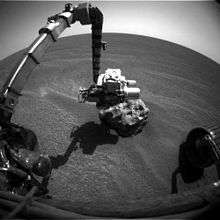Cleaning event




A cleaning event is a phenomenon whereby dust is removed from solar panels, particularly ones on Mars, by the action of wind. The term cleaning event is used on several NASA webpages; generally the term is used in reference to the fact that Martian winds have blown dust clear off the solar panels of probes on Mars increasing their energy output.[1]
The term started being used in 2004 as the Mars Exploration Rovers' solar panels started to benefit from these events.[2] The rovers were expected to last about 90 sols (Martian days) on Mars, after which dust would cover their solar panels and reduce solar power to levels too low for the rovers to operate. However, power levels went back up due to the cleaning events caused by the winds in the Martian atmosphere. Periodic cleaning events have allowed the MER rovers to operate far longer than the planned 3 months. While Spirit rover finally ceased operation in 2011, Opportunity rover remains active as of 2016, more than 12 years after landing.
Cleaning events can either be rapid, such as overnight, or over many days where solar power slowly goes up.[3] For example, the MER-A Spirit rover, on April 18, 2009 and April 28, 2009 the power output of the solar arrays were increased by cleaning events.[4][5] The power output of Spirit's solar arrays increased from 223 watt hours per day on March 31, 2009 to 372 watt hours per day on April 29, 2009.[5]
Other factors that affect solar power output include the opacity of the Martian atmosphere and Martian seasonal changes.
The Materials Adherence Experiment had a glass plate that allowed the dust to be cleared off and protected a Gallium arsenide photo-cell. It was part of the Mars Pathfinder program in the 1990s.
See also
- Atmosphere of Mars
- Curiosity rover
- Exploration of Mars
- MER Mars Exploration Rover mission
- MER-A Spirit rover
- MER-B Opportunity rover
- Solar panel
References
- ↑ "NASA Mars Rover Churns Up Questions With Sulfur-Rich Soil". NASA/JPL. March 14, 2007.
- ↑ "Mystery of Mars rover's 'carwash' rolls on". New Scientist. December 23, 2004. Retrieved Oct 4, 2015.
- ↑ "Cleaning Event Boosts Power On Opportunity". Mars Daily. August 2, 2006.
- ↑ "Another Reset and a Cleaning Event". NASA/JPL. 2009-04-22. Retrieved 2009-04-25.
- 1 2 "Well Behaved, Less Dusty, in Difficult Terrain". NASA/JPL. 2009-04-29. Retrieved 2009-05-04.
External links
![]() Media related to Mars Exploration Rover at Wikimedia Commons
Media related to Mars Exploration Rover at Wikimedia Commons
